Abstract
Umbilical venous blood, and umbilical arterial blood pH, PO2, PCO2, and base excess were determined in 453 term infants at birth. The results indicate that umbilical venous blood pH, and umbilical arterial blood pH are significantly related to each another. Acidosis, as defined by an umbilical venous blood pH less than 7 X 27, is associated with a lower PO2, a raised PCO2, and a reduced buffer base when compared with PO2, PCO2, and buffer base associated with a normal pH (7 X 27-7 X 42), or alkalosis (pH greater than 7 X 42). The infant's condition at birth was recorded using modified Apgar scores, in which the gradings were vigorous (5-6), intermediate (3-4), or depressed (0-2). In the neonatal period, neurological abnormalities occurred in infants who had been in a depressed condition at birth in the presence of acidosis. Other infants, who had been in a depressed condition with a normal pH or alkalosis and the remaining infants who had an intermediate or a vigorous condition at birth, did not manifest neurological abnormalities in the neonatal period. Our findings suggest that measurement of umbilical venous blood pH, whose values correlate well with those of umbilical arterial blood pH, in infants who are in a depressed condition at birth improves the clinical assessment of the severity of asphyxia.
Full text
PDF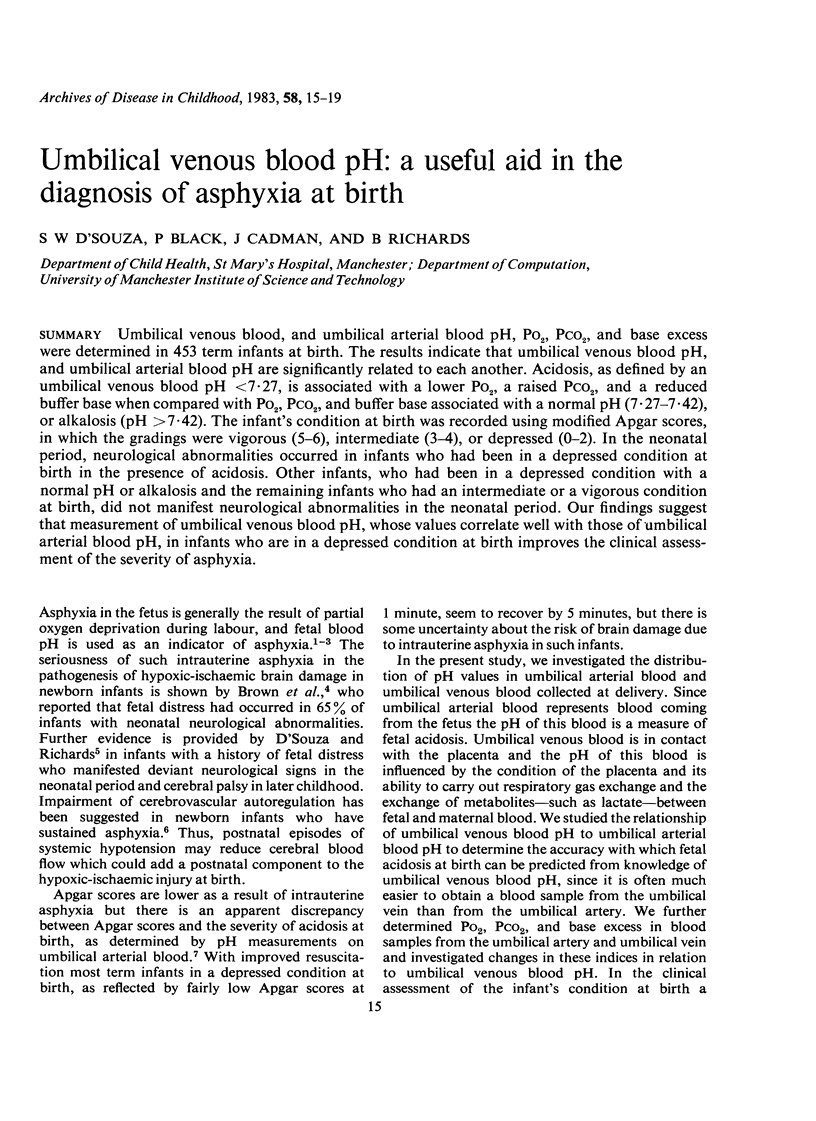
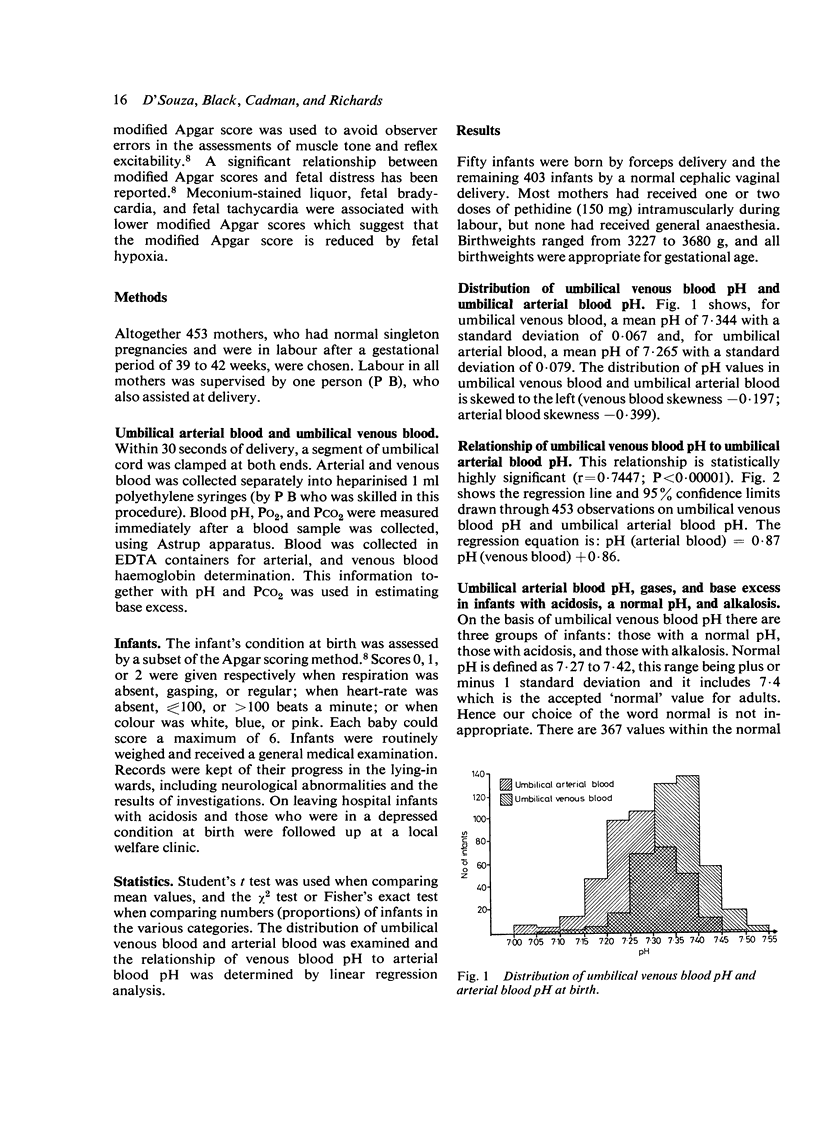
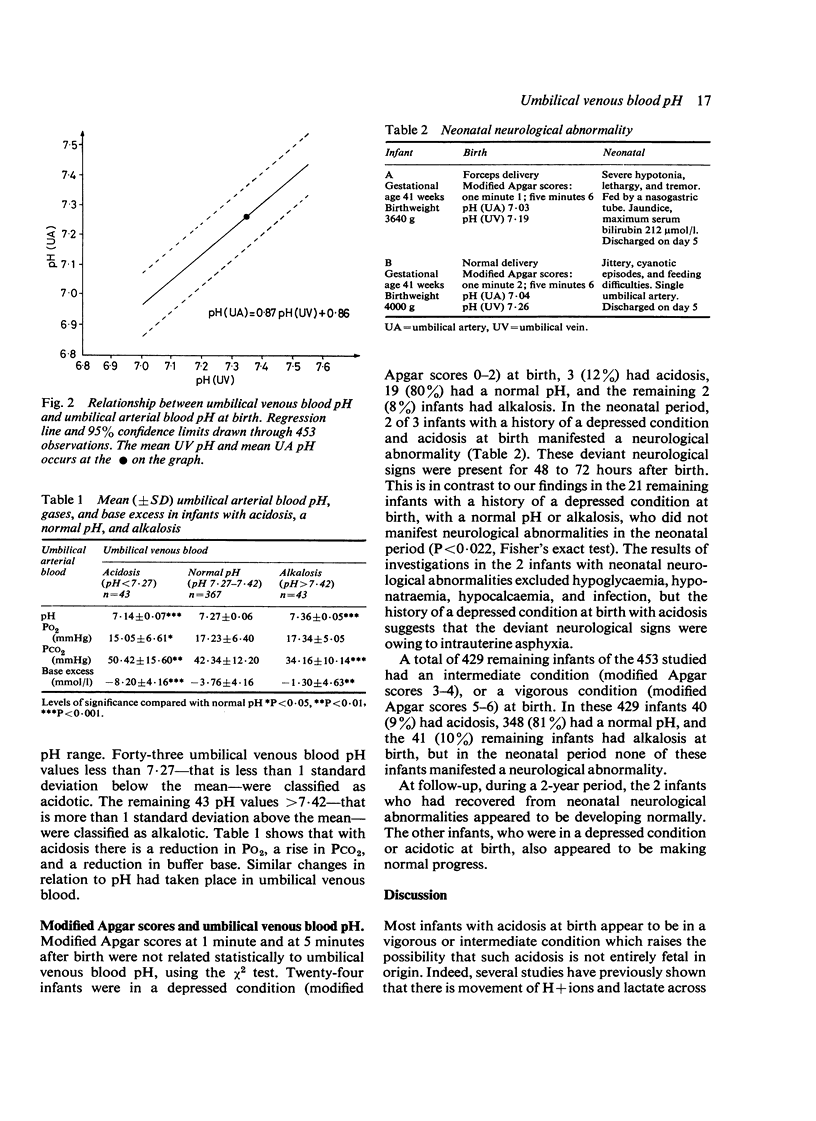
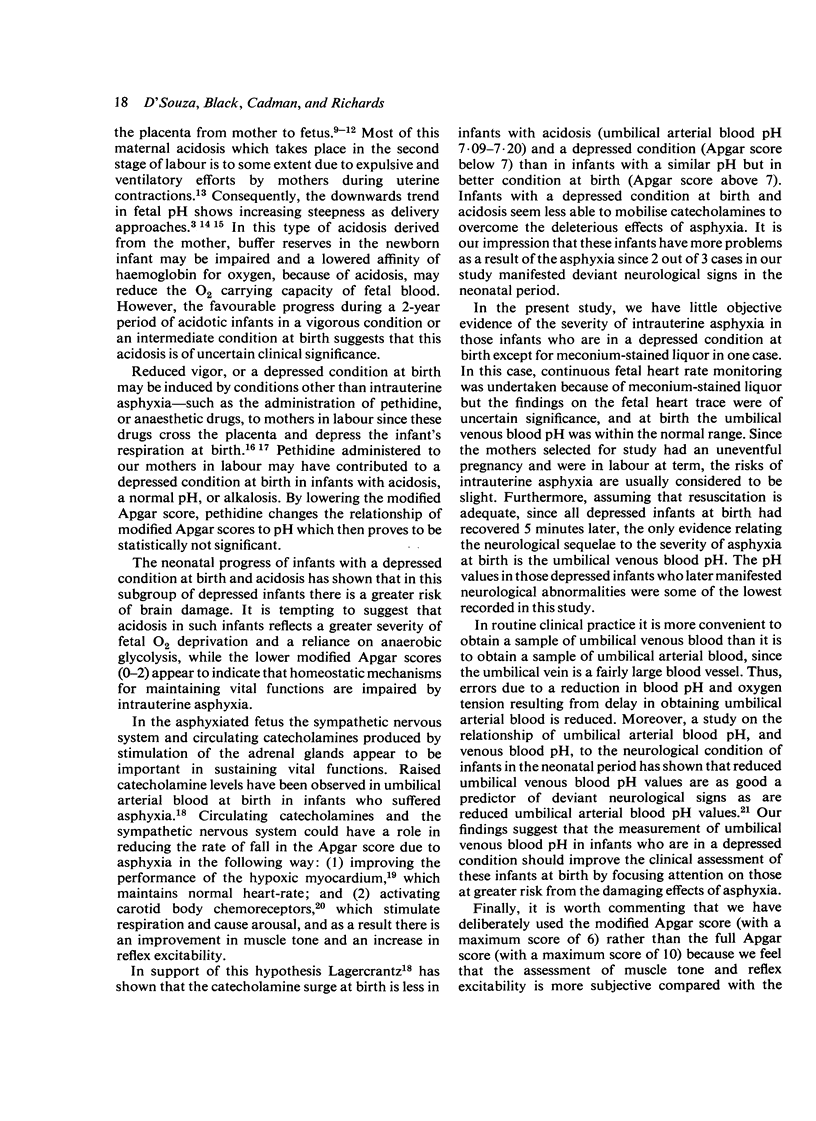
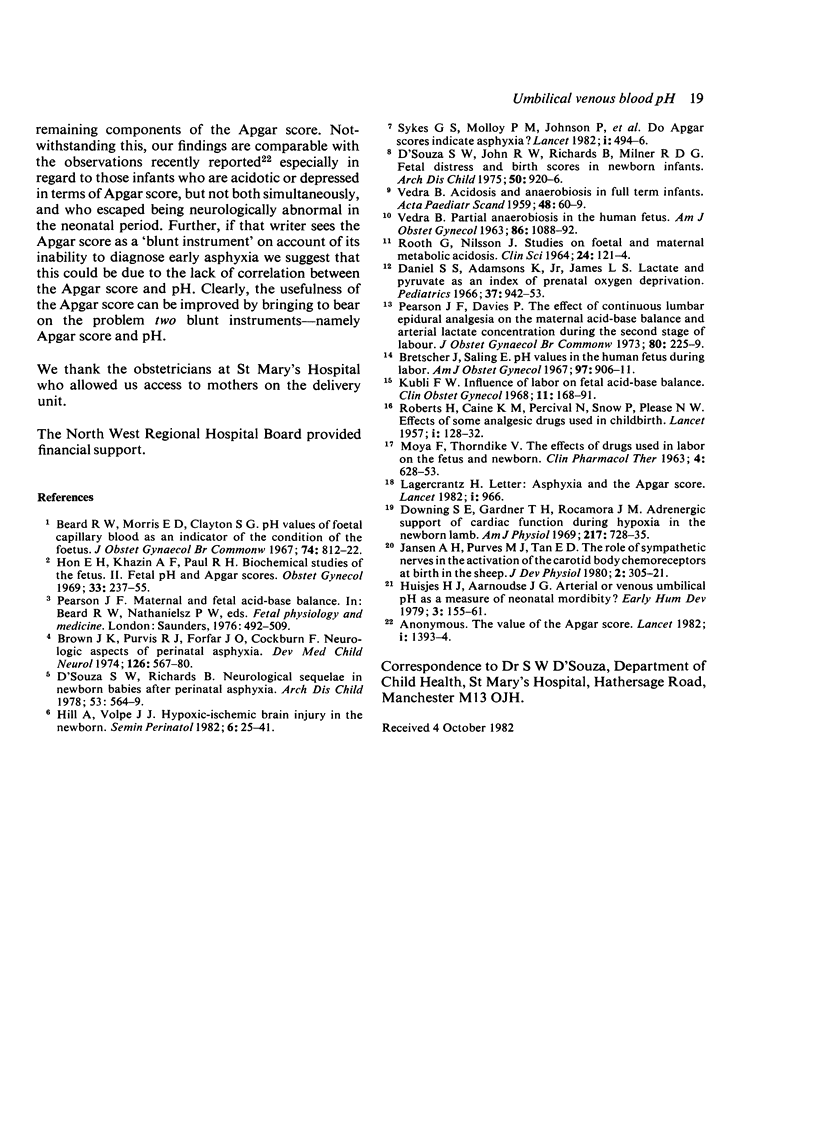
Selected References
These references are in PubMed. This may not be the complete list of references from this article.
- Beard R. W., Morris E. D., Clayton S. G. pH of foetal capillary blood as an indicator of the condition of the foetus. J Obstet Gynaecol Br Commonw. 1967 Dec;74(6):812–822. doi: 10.1111/j.1471-0528.1967.tb15562.x. [DOI] [PubMed] [Google Scholar]
- Bretscher J., Saling E. pH values in the human fetus during labor. Am J Obstet Gynecol. 1967 Apr 1;97(7):906–911. doi: 10.1016/0002-9378(67)90515-7. [DOI] [PubMed] [Google Scholar]
- Brown J. K., Purvis R. J., Forfar J. O., Cockburn F. Neurological aspects of perinatal asphyxia. Dev Med Child Neurol. 1974 Oct;16(5):567–580. doi: 10.1111/j.1469-8749.1974.tb04176.x. [DOI] [PubMed] [Google Scholar]
- Daniel S. S., Adamsons K., Jr, James L. S. Lactate and pyruvate as an index of prenatal oxygen deprivation. Pediatrics. 1966 Jun;37(6):942–953. [PubMed] [Google Scholar]
- De Souza S. W., John R. W., Richards B., Milner R. D. Fetal distress and birth scores in newborn infants. Arch Dis Child. 1975 Dec;50(12):920–926. doi: 10.1136/adc.50.12.920. [DOI] [PMC free article] [PubMed] [Google Scholar]
- De Souza S. W., Richards B. Neurological sequelae in newborn babies after perinatal asphyxia. Arch Dis Child. 1978 Jul;53(7):564–569. doi: 10.1136/adc.53.7.564. [DOI] [PMC free article] [PubMed] [Google Scholar]
- Downing S. E., Gardner T. H., Rocamora J. M. Adrenergic support of cardiac function during hypoxia in the newborn lamb. Am J Physiol. 1969 Sep;217(3):728–735. doi: 10.1152/ajplegacy.1969.217.3.728. [DOI] [PubMed] [Google Scholar]
- Hill A., Volpe J. J. Hypoxic-ischemic brain injury in the newborn. Semin Perinatol. 1982 Jan;6(1):25–41. [PubMed] [Google Scholar]
- Hon E. H., Khazin A. F., Paul R. H. Biochemical studies of the fetus. II. Fetal pH and apgar scores. Obstet Gynecol. 1969 Feb;33(2):237–255. [PubMed] [Google Scholar]
- Huisjes H. J., Aarnoudse J. G. Arterial or venous umbilical pH as a measure of neonatal morbidity? Early Hum Dev. 1979 Jul;3(2):155–161. doi: 10.1016/0378-3782(79)90004-5. [DOI] [PubMed] [Google Scholar]
- Jansen A. H., Purves M. J., Tan E. D. The role of sympathetic nerves in the activation of the carotid body chemoreceptors at birth in the sheep. J Dev Physiol. 1980 Oct;2(5):305–321. [PubMed] [Google Scholar]
- KANE K. M., PERCIVAL N., PLEASE N. W., ROBERTS H., SNOW P. Effects of some analgesic drugs used in childbirth; with special reference to variation in respiratory minute volume of the newborn. Lancet. 1957 Jan 19;272(6960):128–132. [PubMed] [Google Scholar]
- Kubli F. W. Influence of labor on fetal acid-base balance. Clin Obstet Gynecol. 1968 Mar;11(1):168–191. doi: 10.1097/00003081-196803000-00010. [DOI] [PubMed] [Google Scholar]
- MOYA F., THORNDIKE V. THE EFFECTS OF DRUGS USED IN LABOR ON THE FETUS AND NEWBORN. Clin Pharmacol Ther. 1963 Sep-Oct;4:628–653. doi: 10.1002/cpt196345628. [DOI] [PubMed] [Google Scholar]
- Pearson J. F., Davies P. The effect on continuous lumbar epidural analgesia on maternal acid-base balance and arterial lactate concentration during the second stage of labour. J Obstet Gynaecol Br Commonw. 1973 Mar;80(3):225–229. doi: 10.1111/j.1471-0528.1973.tb02189.x. [DOI] [PubMed] [Google Scholar]
- ROOTH G., NILSSON I. STUDIES ON FOETAL AND MATERNAL METABOLIC ACIDOSIS. Clin Sci. 1964 Feb;26:121–132. [PubMed] [Google Scholar]
- Savage M. O., Mirakian R., Harries J. T., Bottazzo G. F. Could protracted diarrhoea of infancy have an autoimmune pathogenesis? Lancet. 1982 Apr 24;1(8278):966–967. doi: 10.1016/s0140-6736(82)91965-1. [DOI] [PubMed] [Google Scholar]
- Sykes G. S., Molloy P. M., Johnson P., Gu W., Ashworth F., Stirrat G. M., Turnbull A. C. Do Apgar scores indicate asphyxia? Lancet. 1982 Feb 27;1(8270):494–496. doi: 10.1016/s0140-6736(82)91462-3. [DOI] [PubMed] [Google Scholar]
- VEDRA B. "PARTIAL ANAEROBIOSIS" IN THE HUMAN FETUS. OXYGEN CONTENT AND ARTERIOVENOUS LACTATE DIFFERENCES IN UMBILICAL CORD BLOOD. Am J Obstet Gynecol. 1963 Aug 15;86:1088–1092. doi: 10.1016/s0002-9378(16)35301-7. [DOI] [PubMed] [Google Scholar]
- VEDRA B. Acidosis and anaerobiosis in full term infants. Acta Paediatr. 1959 Jan;48(1):60–69. [PubMed] [Google Scholar]


